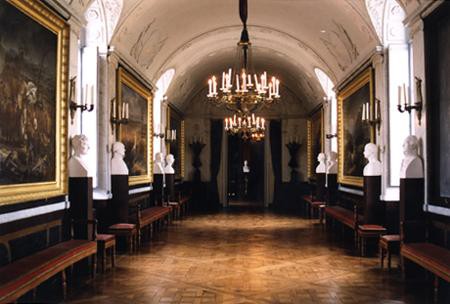At the end of the 16th century, the treasurer of the 'Epargne', lord of Blayes and Chardonnet, Raoul Moreau, built a château on the previously royal land of Grosbois. This estate was subsequently sold to the son of Charles IX, Charles d'Angoulème. And it was Angoulème who gave the park and the château its present-day aspect.
Although the estate was 'nationalised' under the Revolution, Barras bought it in Year VI (i.e., 1797) and lived there in insolent opulence. After the coup d'état of 18 Brumaire, he retired to the château with 'gold and women, to live an extravagant lifestyle, dining sybaritically'. Barras received Fouché there, and Fouché took with him the offer of a post from Bonaparte and Josephine – but Josephine was unable to win Barras to her husband's support. Forced into exile in Brussels, Barras sold Grosbois and it was bought through several intermediaries by Fouché.
The château was then purchased by Berthier who had been made Maréchal de l'Empire in 1804, and the site was to remain in his family until 1962 when it was sold to the Society for the Encouragement of the Breeding of French Horses (Société d'Encouragement à l'Elevage du Cheval français), a world-renowned training centre for trotting horses.
The Château de Grosbois is today home to a great deal of Berthier family memorabilia, and a large part is given over to Napoleonic matters. The Salon des Huissiers (Bailiffs' salon), the first room in the visit, contains several portraits of Berthier, notably one by Gros showing the future Maréchal at the Battle of Lodi. The Salon de l'Empereur, the next room, has an ensemble of paintings: Napoleon in his coronation robes by Gerard; a full-length portrait of the emperor, in 1810, dressed as a colonel of the Chasseurs of the Guard painted by Robert Lefevre; The Battle of Marengo by Carle Vernet; and the original map of the Battle of Wagram drawn up by Berthier in 1809.
The following room, the Galerie des Batailles (Battle Gallery – see above illustration), was designed by Berthier himself as a celebration of the Napoleonic epic. The gallery itself is decorated with regularly-placed, fluted pilasters surmounted by a barrel vault ornamented with palms and discreet stucco work. The pictures on display show the great battles in which Berthier played a part (Lodi and Rivoli by Carle Vernet, the Battle of the Pyramids by Vincent, Marengo by Pajou, Austerlitz by Meynier, Iena by Thévenin, Eylau by Rohan, and Wagram by Gros). And this ensemble evoking the great events of the Empire is completed with busts of the Maréchaux. The very end of the gallery opens into a library containing three thousand books, presided over by a bust of Napoleon by Canova. The library also boasts a Second Empire ceiling and pictures of Berthier's children by Winterhalter.
The next room, Berthier's study (which contains some beautiful furniture) has a grand view of the park and, on the horizon, an obelisk on which the names of the great Napoleonic battles are inscribed. In the Salon Régence there is some very beautiful eighteenth century woodwork, whilst in the Salon de Chasseurs (Hunters' Salon) there are hunting pictures by Desportes and Oudry recalling the famous hunts organised in the park. Indeed it was at a hunt given 3 December 1809 that Josephine appeared for the last time in public as Empress before her divorce was published a few days later. It was also at Grosbois that Marie-Louise spent her first night in exile, 23 April 1814, en route for Vienna with the King of Rome.
Finally, there are important frescoes in the dining room, painted in the seventeenth century from sketches by Abraham Bosse.
Château de Grosbois Napoleonic Museum


